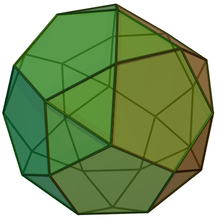Loading AI tools
Solid made from 2 rotunda joined base-to-base From Wikipedia, the free encyclopedia
In geometry, a birotunda is any member of a family of dihedral-symmetric polyhedra, formed from two rotunda adjoined through the largest face. They are similar to a bicupola but instead of alternating squares and triangles, it alternates pentagons and triangles around an axis. There are two forms, ortho- and gyro-: an orthobirotunda has one of the two rotundas is placed as the mirror reflection of the other, while in a gyrobirotunda one rotunda is twisted relative to the other.
| Set of cupolae | |
|---|---|
 Example: pentagonal orthobirotunda | |
| Faces | 2 n-gons 2n pentagons 4n triangles |
| Edges | 12n |
| Vertices | 6n |
| Symmetry group | Ortho: Dnh, [n,2], (*n22), order 4n Gyro: Dnd, [2n,2+ ], (2*n), order 4n |
| Rotation group | Dn, [n,2]+, (n22), order 2n |
| Properties | convex |
The pentagonal birotundas can be formed with regular faces, one a Johnson solid, the other a semiregular polyhedron:
Other forms can be generated with dihedral symmetry and distorted equilateral pentagons.
| 4 | 5 | 6 | 7 | 8 |
|---|---|---|---|---|
 square orthobirotunda |
 pentagonal orthobirotunda |
 hexagonal orthobirotunda |
 heptagonal orthobirotunda |
 octagonal orthobirotunda |
 square gyrobirotunda |
 pentagonal gyrobirotunda (icosidodecahedron) |
 hexagonal gyrobirotunda |
 heptagonal gyrobirotunda |
 octagonal gyrobirotunda |
Seamless Wikipedia browsing. On steroids.
Every time you click a link to Wikipedia, Wiktionary or Wikiquote in your browser's search results, it will show the modern Wikiwand interface.
Wikiwand extension is a five stars, simple, with minimum permission required to keep your browsing private, safe and transparent.